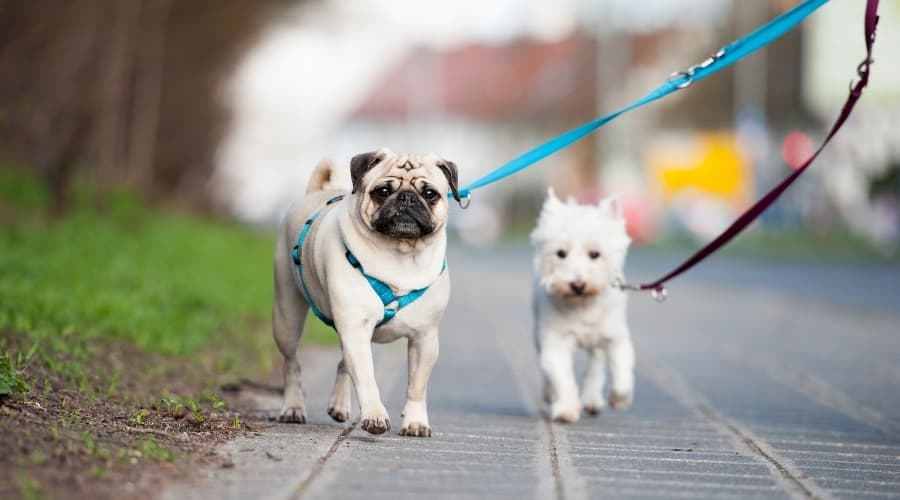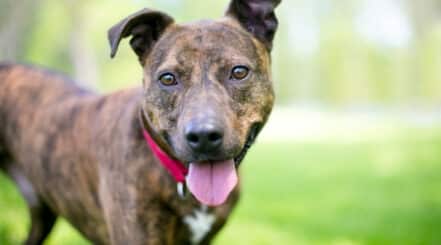We tend to think our pups should naturally pee or poop when their paws hit the grass. Trained dogs should feel the need to relieve themselves when outside, so why do some dogs struggle with the concept? If your dog doesn’t pee or poop on your walks, just know you are not alone.
While walks can encourage many dogs to “do their business” near where other dogs have gone before, not all canines will follow in the prior dog’s footsteps. This can be frustrating as a dog owner, and it can prolong walks while you encourage your pup to “go.”
So why do some dogs struggle with going potty on walks? In this article, we will discuss this behavior in our canine companions, and help you encourage your pup to do their business on the leash.
Is This Normal Behavior?

While we expect our dogs to naturally go to the bathroom while outside on walks, some pups can struggle with this concept. This is especially common in dogs new to walking on a leash or even young dogs still being potty trained. A dog not peeing or pooping while on walks is fairly normal behavior. It should be easy to fix in most furry friends.
Why Won’t My Dog Potty On Walks?
There are many reasons why your pup may be hesitant to go potty while on walks. Ranging from discomfort on leashes to fear of their surroundings, some dogs can really struggle with the idea. While it can be frustrating as a dog owner to experience this behavior, it’s not at all uncommon.
Understanding why your pup is struggling is the first step in properly training your pup. To help you better understand your furry friend, let’s discuss some of the most common reasons why dogs won’t pee or poop during their walks.
Leashes Can Be Uncomfortable

Walking on a leash can be a tricky concept for some dogs to grasp. Going from having full control of their movements to suddenly being restricted can be challenging, especially for dogs that have never walked on a leash before. If your dog is uncomfortable on a leash in general, they will likely struggle with going potty while on walks.
Not only can some dogs be fearful of walking on a leash, but some dogs can simply have a bad relationship with their lead. If your pup is pulling constantly on their leads and is being corrected, this may not be an enjoyable experience. This can cause them to become frustrated while on walks, making it more challenging to properly do their business.
Leashes Limit Exploring Abilities

Some dogs need more sniffing room than others when trying to go potty outside. While some pups may be able to pee on command with limited space, other dogs need to explore their area fully before choosing the perfect spot. This can be challenging for a dog to do if they are on a short lead, as this stifles their ability to scope out the perfect potty spot.
Your Pup Is Too Excited

If your pup appears overwhelmed with excitement on your walks, they may have a hard time going potty. Peeing and pooping require concentration, and an excited pup often struggles with concentrating on one task. An excited dog is easily distracted by new scents, passing humans, and other dogs. It’s possible they may get distracted by pretty much anything that crosses their path.
Anxiety Could Be Taking Over

If your pup struggles with feeling confident in their skin, they may be too anxious on your walks to focus on going potty. This may cause them to have other anxious behavior, which may include staring at you longer than normal when they potty.
Some dogs struggle with fear of their leashes. They may also struggle in the environment around them, or if they are surrounded by unknown humans and animals. Each of these things is encountered while out on a walk, making this experience scary for some dogs.
Improper Potty Training

If your dog does not understand the idea of potty training, they may not know they are supposed to do their business while on walks. If a dog has not yet associated the outdoors with their designated potty zone, they may not pee or poop as expected the moment they touch the grass. These dogs are usually less understanding of being on a leash, making the entire process very confusing.
Potty Training While Walking
If your pup struggles with going pee and poop during walks, there are a few ways to help them catch on. Some pups require extra guidance when learning how to go potty on a leash. Most dogs catch on quickly when owners are consistent.
Establish A Potty Routine

Dogs of all ages and breeds crave routine. Routine and structure offer our furry friends security and helps them catch on to desired behaviors and habits. A potty routine ideal for helping your pup grasp potty training in general. But it can help them better understand going pee and poop while on walks.
When you are teaching your dog to go potty while on walks, you will need to take them outside more often than you think you need to. You should take your dog out on a leash when they wake up, after eating, after any naps, after returning home, and before bedtime. When sticking to this routine, you eliminate the chance of going potty elsewhere. This will also help them understand that walk time is potty time.
Stick To A Set Feeding Schedule

Sticking to a set feeding routine can help your pup in every aspect of potty training. Not only can this help your pup have a more regular poop routine, but it can also help you better understand when your dog usually has to go. By learning the times of day your pup typically does their business, you can better craft your walking routine around their habits.
Use A Long Leash

If you think the leash is the issue in your dog’s struggles, it may be time to offer them a longer leash. Some dogs have a hard time choosing the perfect spot when on a short lead, causing them to refuse to pee or poop on walks. This is common in dogs not used to walking on a leash. It’s also common with dogs who are used to having ample room to explore when they are outside.
It is also possible the leash feels rough around their neck. An alternative to using a leash is a good, escape-proof dog harness. This can be a lot more comfortable for those dogs who struggle with the collar tightening on their neck when pulling. If the walk is more enjoyable, it can help promote your pooch to potty.
Desensitize Their Triggers

If your pup is too anxious to go potty on your walks, it may be time to work on desensitizing their triggers. This will vary from dog to dog, as each pup may have its own set of fears.
For example, if your dog reacts to other dogs on walks, you will need to desensitize your pup from the presence of other dogs. You can do this by taking them on walks in areas where they may see dogs. You’ll then distract them with praise or other forms of positive reinforcement when dogs are around. You can also try socializing your dog in a controlled setting.
The best way to desensitize a dog from triggers is by exposing them to the trigger in a controlled setting and allowing them to get used to the trigger on their own time. If at any point you think your pup requires training outside of your comfort, it’s best to contact a professional dog trainer.
Help Them Gain Confidence

A confident dog is more likely to feel secure in its own skin. This is especially important for dogs fearful on walks, as they often struggle to feel comfortable in an unknown environment.
You can help your dog gain confidence by teaching them basic obedience, socializing them, and exposing them to more environments. If you put in the effort to help them gain confidence, you will see the benefits trickle into every struggle they face!
Find A Safe Potty Area

Some areas are simply too chaotic for a dog to go to the bathroom in comfort. This can make them more hesitant to go on walks in general, and can certainly distract them when it is time to pee or poop.
The best potty areas are free from loud traffic, filled with plenty of grass for them to go to the bathroom, and do not contain a large number of potential distractions. This may be harder to find in some areas than others. But it can help your dog focus on going potty during your walks.
Final Thoughts
As you can see, there are many reasons some dogs struggle with peeing and pooping on walks. Keep in mind that no two dogs are the same, and every pup will react differently. If you’ve recently adopted a rescue dog, it can take several months for them to settle into a proper routine. Pups that don’t go to the bathroom on their walks typically aren’t something to worry about in the long term. The behavior is trainable over time if you remain consistent.






My puppy is 7month old dose not poo out side done it once but dose pee Sharon